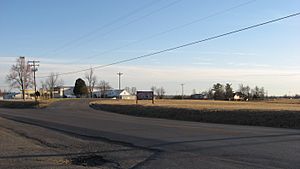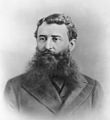Battle of Sacramento (Kentucky) facts for kids
Quick facts for kids Battle of Sacramento |
|||||||
|---|---|---|---|---|---|---|---|
| Part of the American Civil War | |||||||
 Overview of the site of the Battle of Sacramento, located off the western side of Kentucky Routes 81/85 just south of the city of Sacramento, Kentucky |
|||||||
|
|||||||
| Belligerents | |||||||
| Commanders and leaders | |||||||
| Strength | |||||||
| 200-300 | 500 | ||||||
| Casualties and losses | |||||||
| 2 killed, three wounded. | 10 killed and 13 captured according to Union sources, nearly 100 killed and thirty-five captured according to Confederate sources. | ||||||
|
Battle of Sacramento Battlefield
|
|
| Location | Junction of Kentucky Routes 81 and 85 in Sacramento |
|---|---|
| Area | 30 acres (12 ha) |
| Built | 1861 |
| NRHP reference No. | 97000875 |
| Added to NRHP | March 24, 1998 |
The Battle of Sacramento was a small but important fight during the American Civil War. It happened in Sacramento, Kentucky, on December 28, 1861. About 200-300 Confederate cavalry soldiers, led by Colonel Nathan Bedford Forrest, attacked a larger Union force of 500 soldiers. The Union soldiers, led by Major Eli H. Murray, were getting water for their horses near the Green River. Forrest's troops surrounded and defeated them.
The exact number of soldiers hurt or captured is not clear, as both sides reported different numbers. However, many people who saw the battle said that Forrest was very brave. His leaders also praised him for his courage.
This battle was one of the first times Forrest led soldiers in a fight. It showed many of the clever tactics he would use later in his military career. These included splitting his forces, surrounding the enemy, hiding his movements, and personally leading cavalry charges. This battle was also an early fight for Stovepipe Johnson, who later became a Brigadier-General. The Union force was completely defeated. This battle is often called "Forrest's First Fight" and is re-enacted every year by people in the area.
Contents
Why the Battle Happened
Both the Union Army and the Confederate forces were gathering and training soldiers in Kentucky. This was because many people in Kentucky had mixed feelings about which side to support when the Civil War began.
Early Moves in Kentucky
In September 1861, Confederate Major-General Leonidas Polk started taking over towns in Kentucky. This happened even though other Confederate commanders like Simon Bolivar Buckner and Leroy Walker disagreed. Around the same time, Union Brigadier-General Ulysses S. Grant moved his troops using the Ohio River. He set up his base at Paducah to face the new Confederate General Albert Sidney Johnston.
By October, both armies were trying to get an advantage over the other. Forrest's group of soldiers was ordered to Kentucky from Memphis, Tennessee. They were told to report to Colonel Adolphus Heiman. Heiman was in charge of building Fort Henry and Fort Donelson. He had asked for cavalry soldiers to help protect his work.
Forrest's Early Actions
Forrest brought eight companies of soldiers with him. These soldiers came from Alabama, Kentucky, Tennessee, and Texas. They were trained for close-up fighting and most of them carried shotguns. Forrest quickly made his presence known in the area. On November 20, he set up a surprise attack for a Union gunboat, forcing it to turn back.
He continued to have small fights with gunboats for the rest of November. On November 24, he captured a Union supply center. During this, he barely missed being shot by a sniper, but his doctor was killed instead. Soon after, he received more soldiers, with two new companies joining him from Huntsville, Alabama.
The Battle of Sacramento
On the morning of the battle, Forrest and his cavalry soldiers were getting close to Sacramento. A local supporter named Mollie Morehead told them that the Union soldiers, led by Eli H. Murray, were watering their horses nearby. Forrest had already received reports that morning saying the enemy was moving along the banks of the Green River. He was eager to attack them.
Despite the cold weather and light rain, Forrest led his soldiers to chase the Union troops. Mollie Morehead rode alongside Forrest. He later said that her "untied tresses, floating in the breeze, infused into my arm and kindled knightly chivalry in my heart." This meant her bravery made him feel even more determined.
Forrest's Attack Plan
Forrest led about 200 cavalry soldiers, dividing them into three groups. One group got off their horses to attack from the front. They used bushes and fences to hide themselves. The other two groups stayed on their horses to go around the sides of the Union forces. One of these groups had 30 men, and the other had 60. The Union forces had 500 soldiers, so Forrest was outnumbered.
At first, the Union soldiers weren't sure who the arriving troops were. But once Forrest fired, they started shooting back. Forrest then personally led the cavalry charge. He signaled it by shouting to his bugler, "blow the charge, Isham!" The groups that had gone around the sides then joined in. They fought hand-to-hand with the Union troops, who were now trying to run away.
Led by this impetuous chieftain, we swooped down upon our foes with such terrific yells and sturdy blows as might have them believe a whole army was on them; and turning tail, they fled in the wildest terror, a panic-stricken mass of men and horses... cutting and shooting right and left, and Forrest himself in his fury ignoring all command and always in the thickest of the melee.
—Recollections of Private Adam Johnson, later a Brigadier-General, Confederate forces.
Aftermath of the Battle
A Confederate soldier named James Hammer, who saw the battle, wrote that Forrest personally killed nine enemy soldiers. This happened even after his own horse was shot out from under him. Many of Forrest's officers had never seen him fight before. They were surprised by his strong aggression, which was very different from his usual calm manner.
The Union and Confederate sides have different numbers for how many soldiers were hurt or captured. Union reports say two officers and eight men were killed, and thirteen were captured. Confederate reports say "closer to a hundred" were killed, and thirty-five were captured. Forrest himself dislocated his shoulder when two riderless horses crashed into him.
So fierce did his passion become that he was almost equally dangerous to friend or foe, and, as it seemed to some of us, he was too wildly excitable to be capable of judicious command. Later we became aware that excitement neither paralyzed nor mislead his magnificent military genius.
—Major Kelly, Forrest's second, on his commander's methods.
This battle was Forrest's first victory in combat. During it, he showed several tactics that he would become famous for later. These included dividing his soldiers into groups, using tricks to confuse the enemy, surrounding them, and personally leading the cavalry charge. The battle is often called "Forrest's First Fight." His commander at the time, Brigadier-General Charles Clark, noticed Forrest's "skill, energy and courage."
Clark wrote to his government that "I am assured by officers and men that throughout the entire engagement he was conspicuous for the most daring courage; always in advance of his command. He was at one time engaged in a hand-to-hand conflict with 4 of the enemy, 3 of whom he killed, dismounting and making a prisoner of the fourth." The battlefield was added to the National Register of Historic Places in 1998. Local people re-enact the battle every year.





